After adecade of living in Spain where I could legally grow cannabis for personal consumption, I returned to the USA. Even though I was examined by a doctor and prescribed a Medical Marijuana Identification Card from the State of California, my new home, I still felt uncomfortable with the legal system. When I left the USA years earlier, convicted “criminal medical cannabis gardeners” received long prison sentences, and their homes and assets were confiscated under civil law. It took me a few months to warm up to the new life in California.
This is a brief, three-year history of a backyard garden located in California at latitude 38º north and influenced by Pacific Ocean maritime weather. It is in Sunset Garden Climate Zone 14.
This simple history demonstrates that soil is the essential base of the garden. Sunlight, temperature, and the varieties grown are the next most important factors. Once these elements are in balance, growing outstanding medical cannabis is easy!
The first year, the soil was very bad: heavy clay littered with river-bottom rocks. Drainage was slow, and the soil contained little oxygen or organic matter. Water would accumulate on top of the soil after heavy rains.
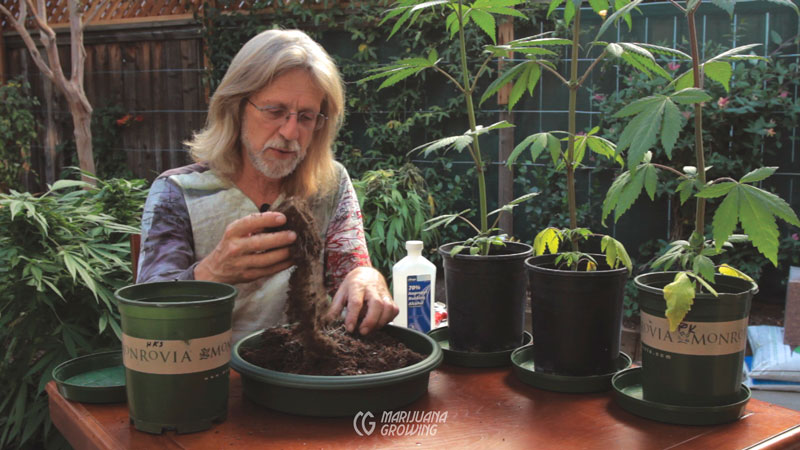
Jorge is always gardening in his backyard!
I started amending the soil in February, tilling in plenty of organic matter— compost, bark dust, sand, and used indoor soil. Chicken manure was added to help break down the bark dust. Bone and kelp meal were added too, but no lime or other supplemental fertilizers.
The soil texture was transformed. Water drained readily with good retention. However, the soil still lacked the proper balance of organic life that it would take two more years to attain.
2010 Backyard Garden
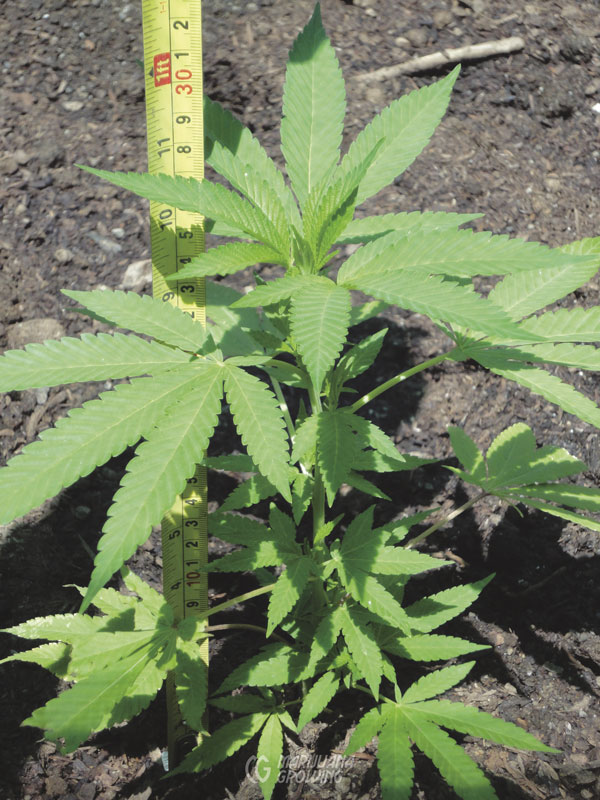
Transplanting date: July 4, 2010
My first crop maintained a low profile; I grew three each of ‘Bubba Kush’ and ‘OG Kush’. These varieties, purchased from a local medical cannabis dispensary, were developed to be grown indoors under lights.
I transplanted the clones in rockwool cubes into 1-gallon (3.8 L) containers. I let them harden-off for more than a week, and then patriotically transplanted the 12-inch-tall (30 cm) clones on the 4th of July—Independence Day in the USA.
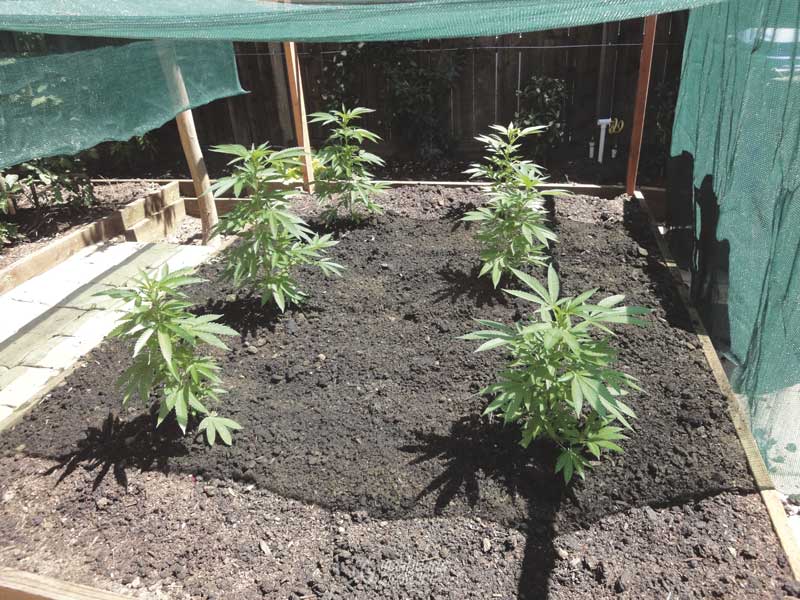
The plants, in a 6 × 10-foot (182.8 × 304.8 cm) bed raised 8 inches (20.3 cm) were covered with green 50 percent shade cloth. The shade cloth was extended over one side to help block ocean breezes.
A week after transplanting, the plants were growing slowly. July days were hot, 86ºF (30ºC), but the nights were cool, 45ºF (7.2ºC). The shade cloth over the plants kept them cooler during the day and warmer at night.
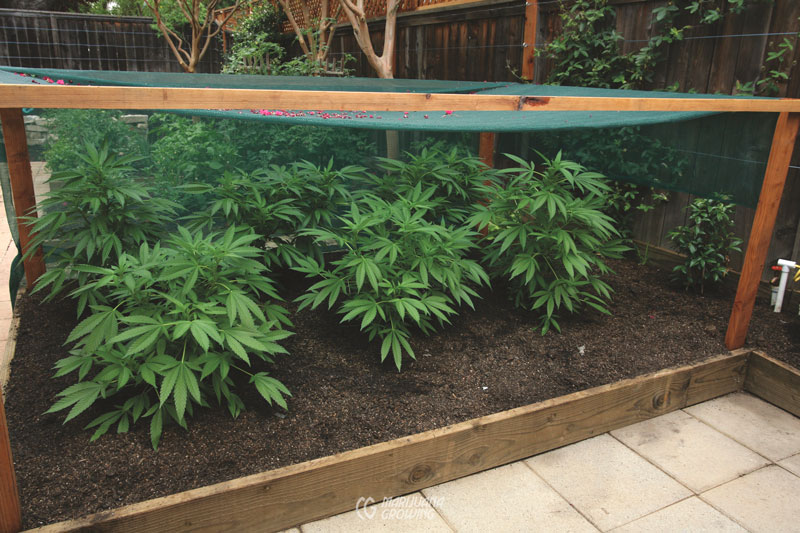
By August 4, the plants were growing well. The shade cloth cooled the soil and lowered water consumption.
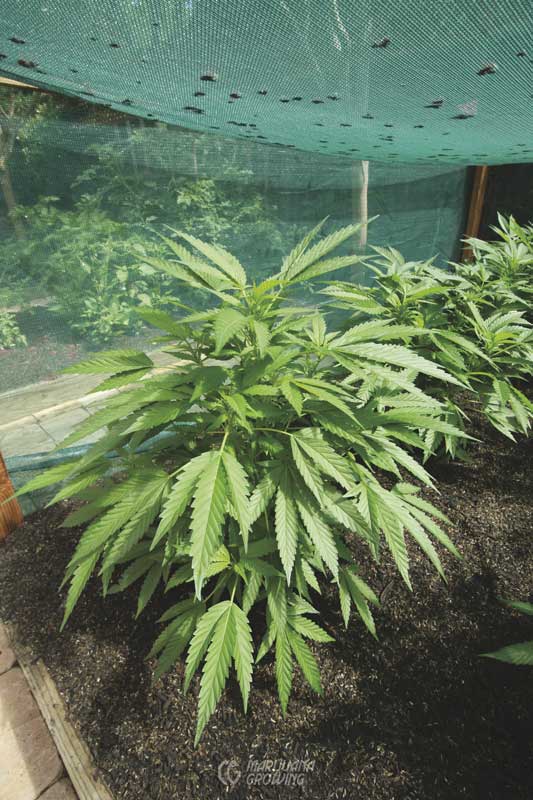
This ‘OG Kush’ plant received plenty of light for rapid growth.
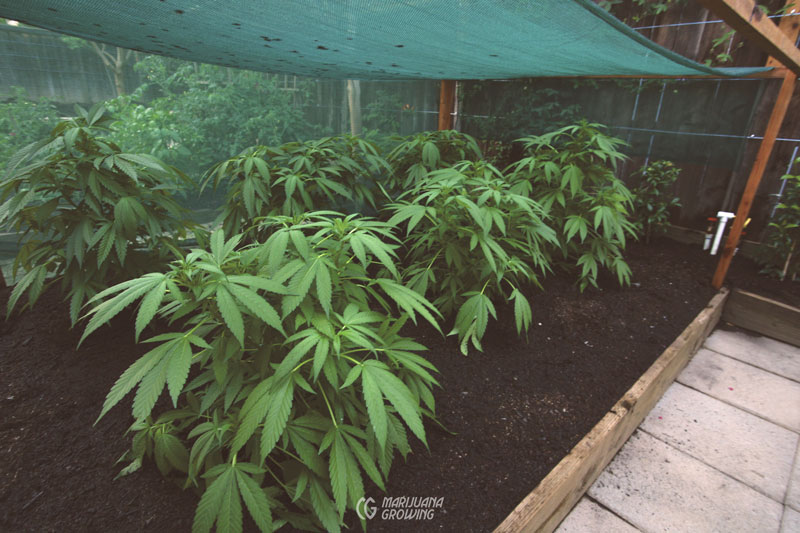
The garden is located between a two-story wall and a tall fence. Once the sun disappears behind the trees and walls, the garden receives low levels of light. Back when the sun was directly overhead, on June 21, the garden área had received almost 6 hours of direct sunlight, but by the first of October the sun was lower in the sky, and just over half the plants received 1 to 4 hours of direct sunlight; the rest received only ambient light. Plants in the foreground were also subjected to light from an adjacent window. Shade cloth helped block the nighttime light so that all parts of the plants matured at the same time.
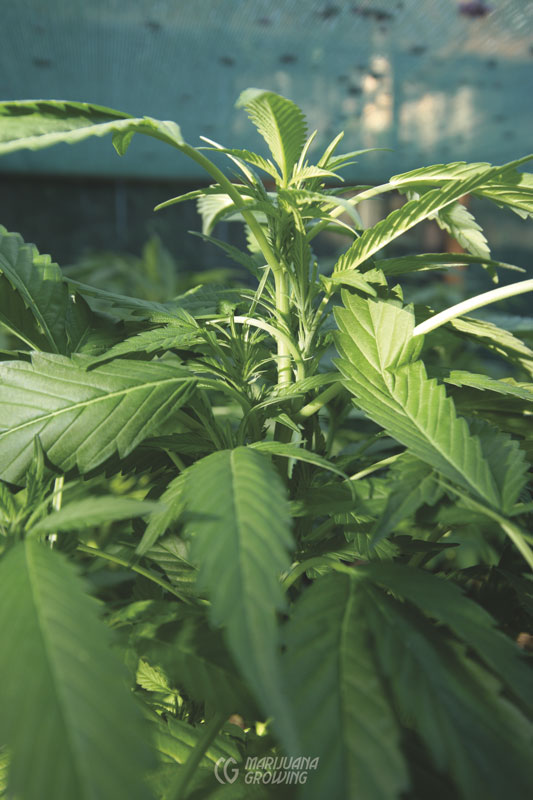
On August 10, female flowers started to grow under 13 hours and 50 minutes of sunlight! By the end of the month, flowering was in full force under 13 hours of daylight and 11 hours of darkness.
Five pounds (2.3 kg) of bat guano was applied and cultivated into the top layer of soil on August 1. The bat guano was expensive, but it helped buds swell and also imparted a sweeter taste.
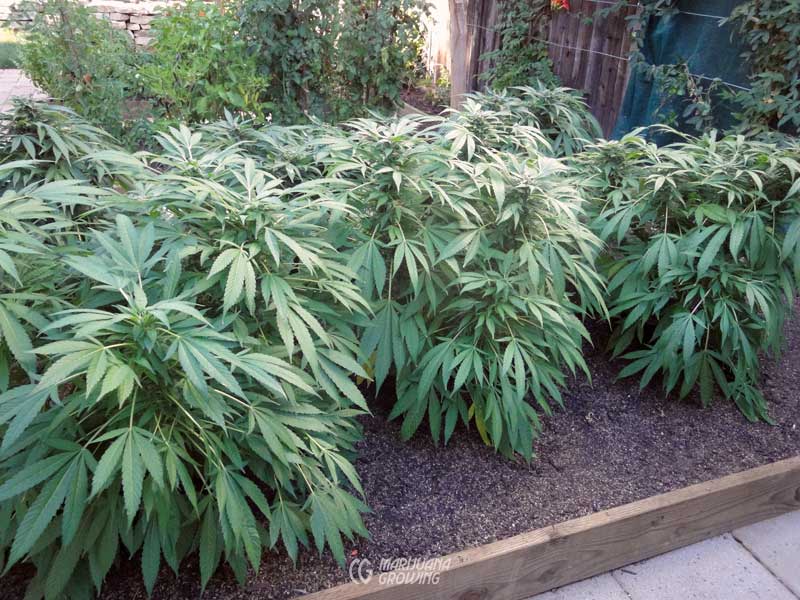
Two weeks before harvest, all foliage was green—including large leaves. A heavy dose of nitrogen (chicken manure) was necessary to combat the bark dust in the soil.
All 6 plants grew to about 3 feet (91 cm) tall, with big, thick flower buds. The first signs of powdery mildew and bud mold started in mid to late August as buds began to thicken. The mold became progressively worse until control measures were taken. Serenade Garden, a broad-spectrum preventative biofungicide, was applied as a spray at 1-week intervals until the first of September. This appeared to keep the disease at bay, but it did little for the disease that had already migrated inside the plant. Bud mold progressed and was cut out when visible.
The cannabinoid-potent crop was harvested one branch at a time, on the first of October.
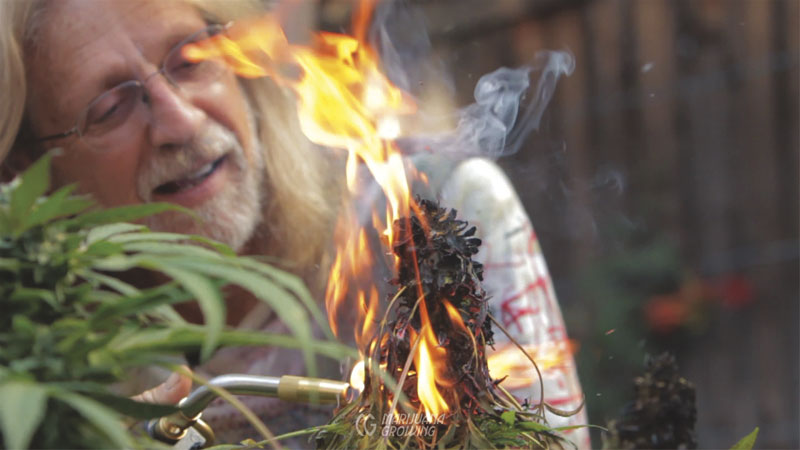
As an experiment, branches with large amounts of bud mold were left in the ground so the disease would progress. The bud mold infected about a dozen big buds. I let them go to see how it would grow. At the end of the experiment, I decided that the best way to banish the mold from these buds was to send it up in smoke!
Caution: Do not try this at home!
2011 Backyard Garden
Transplanting date: June 14, 2011
The second year, clones were transplanted a couple of weeks earlier. The soil absorbed water and retained it much better; 12 months of biological activity had helped the soil mature. The varieties—‘Chemdawg’, ‘Headband’, and ‘Blue Dream’—were more robust; they grew taller and were more resistant (but not immune) to powdery mildew and bud rot (Botrytis cinerea).
At planting time, dispensaries offered the best commercial cuttings available— and the easiest to acquire. Of course my research at the time was based on convenience, and I chose from stock on hand. The indoor varieties were not acclimated to the rigors of outdoors, where stems must be strong, and growth must be sturdy and fast.
The second-year garden was easier to tend because the weather was milder, and the clones were established before high temperatures arrived in late July. Water penetrated the soil better, too. I watered by hand every few days—about 10 gallons (37.9 L) per plant—using an aerating watering wand and local tap water.
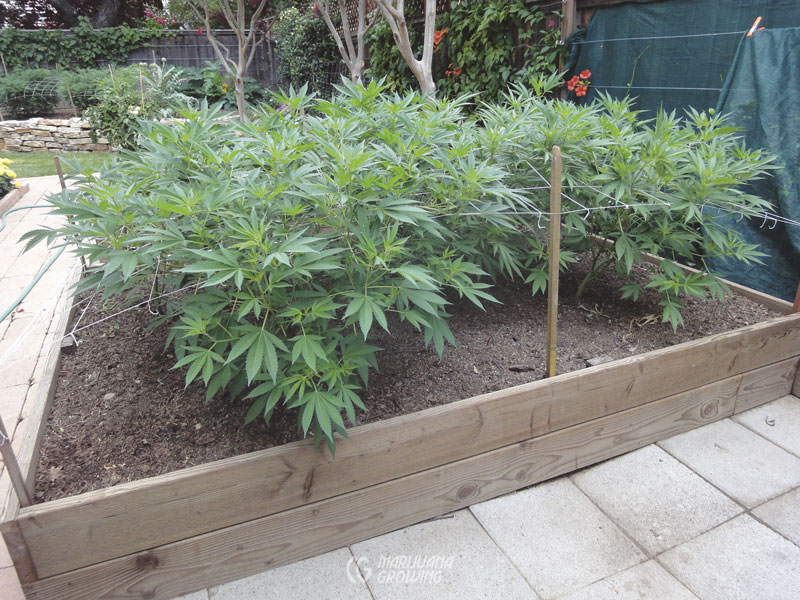
Plants were growing robustly by August 20, and female flower stigmas and bracts had just started to grow.
Branches blew in the wind, and many of them could not support the weight of newly forming flower buds. I installed a horizontal nylon trellis consisting of 6-inch squares. I fastened it to lightweight stakes set in the ground. Aside from transplanting, installing the horizontal trellis was the most work involved in this garden. It took 2 hours to press the posts into the ground, string the trellis, bend the top branches, and clean up.
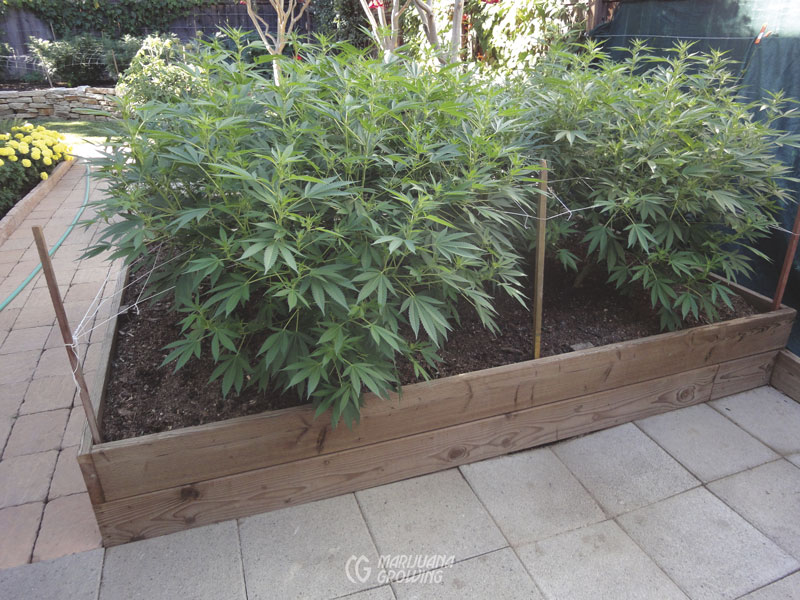
By the last day of August, more small flower buds had formed and branch tips were elongating. The extra 8 inches (20.3 cm) of sideboard added to the raised bed increased the height to 16 inches (40.6 cm). I also added compost-enriched soil to fill the void. The bed warmed sooner in spring, but it got too hot in summer until plants shaded the soil.
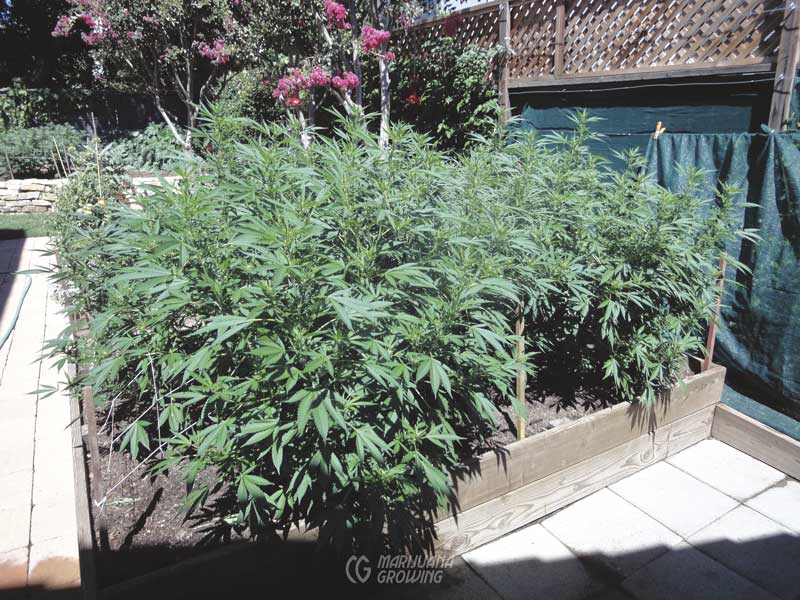
On September 6, just over half the plants received 2 to 5 hours of direct sunlight; the rest received only ambient light.
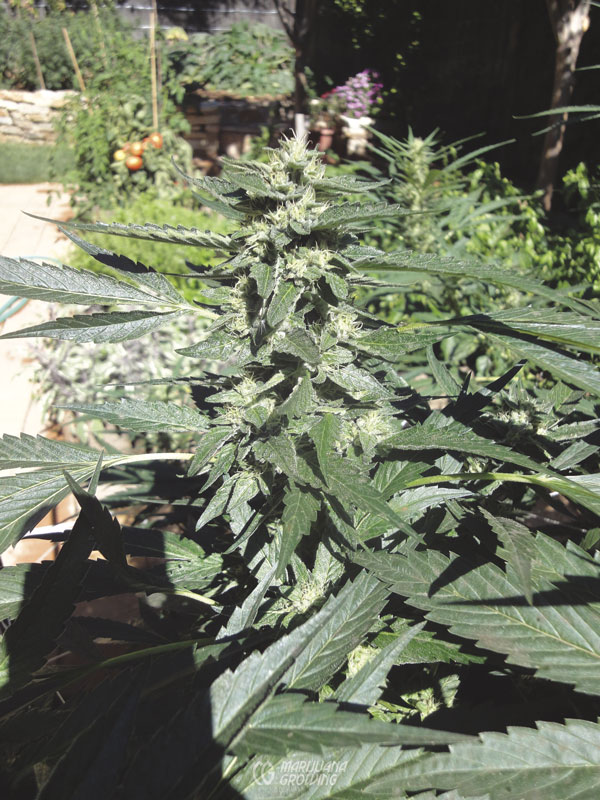
Buds had started to plump up by September 20. Branches of big buds would be harvested in 30 days. Lower branches were left to fatten-up a week or more before harvest.
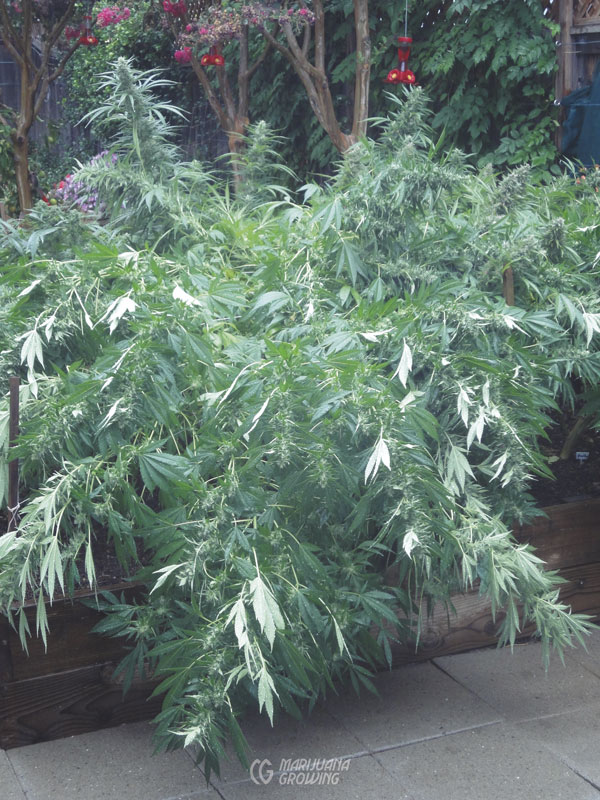
A big rainstorm blew in on October 2. Here, ‘Headband’, a leafy variety with a narrow stem, is shown lying over in front. Strong stems, few leaves, and compact buds kept the ‘Green Crack’ variety standing upright in the background.
Powdery mildew once again haunted the crop but was kept at bay with applications of Serenade Garden every 10 days.

The first bud, with a 2-ounce (56 gm) flower, was taken from ‘Blue Dream’ on October 4. Flower buds from different varieties ripened at different rates, extending the harvest by 2 weeks.
2012 Backyard Garden
Transplanting date: May 15, 2012
The third year, I started with good, strong clones—three ‘Queen Mother × Elvira’ and three ‘Lamb’s Bread × Mother Teresa’—from an expert indoor medical cannabis gardener. They were in 4-inch (10.2 cm) pots and were 12 to 18 inches (30.5 x 45.7 cm) tall, overgrown. The roots were in fair condition: even though a few were brown, most were strong, white, and vibrant.
I left the little clones outdoors in the shade and brought them in at night for 3 days. On May 15, I removed a few lower branches and transplanted the clones about 8 inches (20.3 cm) deep. Planting deeper gave the roots a cool, moist environment. The subterranean stems grew strong new roots in about a month.
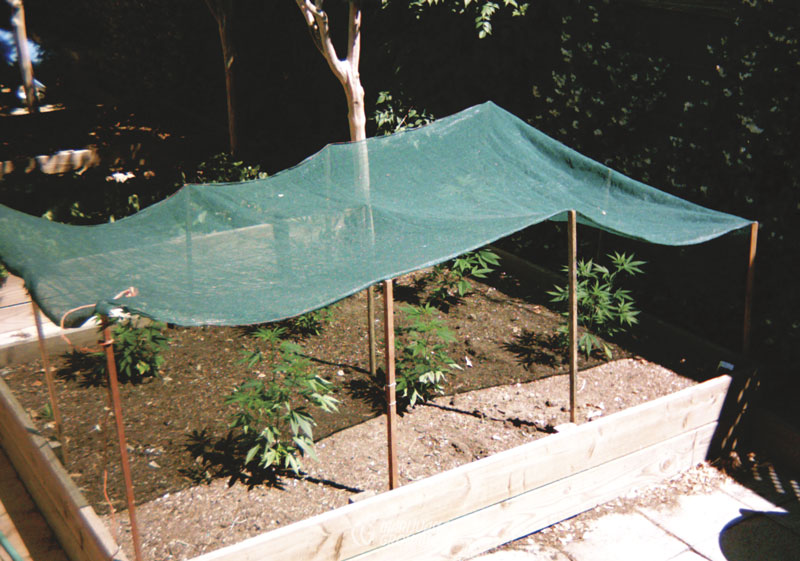
Shade cloth protected the recently transplanted clones from intense sunlight and kept soil cool the first 3 weeks after transplanting. This photo was taken on June 3, after plants were established and had started to grow.
To mount the shade cloth, I drove a few lightweight posts into the ground around the interior of the raised bed and draped 50 percent shade cloth over the tender cuttings and stapled cloth to posts. These clones were planted during a cool spell that lasted several days. (Weather reports are right much of the time!)
The shade cloth was removed a week later, but I put it back on for a few more days when the weather grew hot.
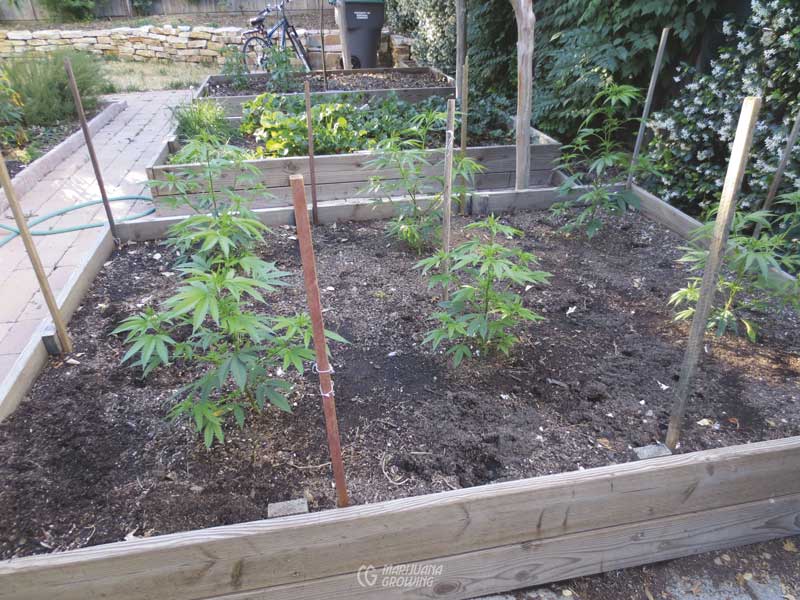
Here, in the first week of June, the established clones were growing well and needed no protection from intense sunlight. Planting earlier took advantage of less-intense sunlight and cooler temperatures. Plants had a chance to become established before warm weather set in.
On June 7, the temperature of the raised bed was about 86ºF (30ºC) during the heat of the day, and about 72ºF (22.2ºC) at a depth of 2 inches (5.1 cm). The raised bed had helped when the days were cool, before the soil warmed. After 2 days, sunlight was heating the bed to temperatures that slowed growth to a crawl.
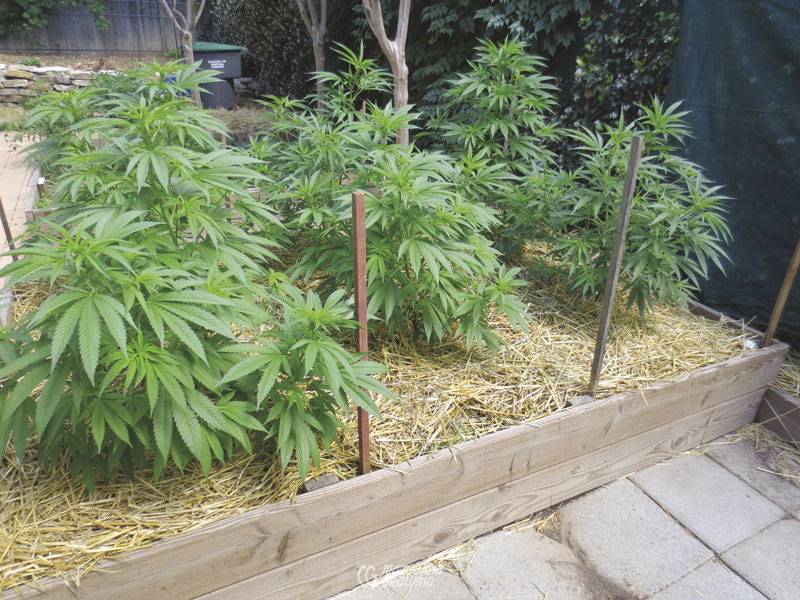
The surface of bare soil was 120ºF (38.9ºC) on June 21. Four inches (10.2 cm) belowground, temperatures had climbed to 86ºF (30ºC). A 6-inch (15.2 cm) layer of straw mulch cooled the surface to 70ºF (21.1ºC) and 4 inches (10.2 cm) belowground to 66ºF (18.9ºC). Plants began to grow 1 to 2 inches (2.5–5.1 cm) daily.

By July 12, the plants had outgrown the bed and needed support and bending. A new 4-foot (121.9 cm) wire fence with 6-inch (15.2 cm) squares around two thirds of the garden provided support to bent branches. I left the shady sides open to provide easy access to the interior of the bed. I trained branches on the perimeter through the 6-inch (15.2 cm) squares in the fence to provide stability. Bending slowed upward growth and kept plants below the fence. Bending branch tips also promoted bushier growth.
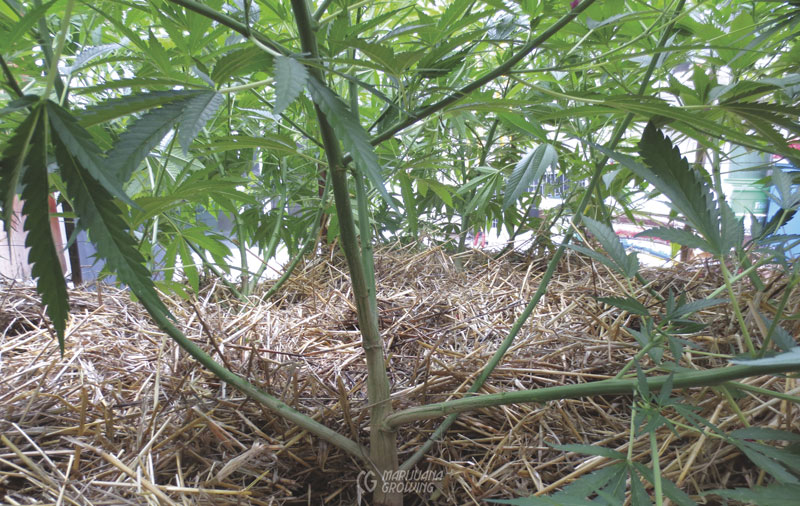
Overgrown bent plants needed thinning below to allow for air circulation and promote growth aboveground that received intense sunlight. On July 17, I cut off branches and leaves, using sharp pruning clippers to avoid wounding the plants.
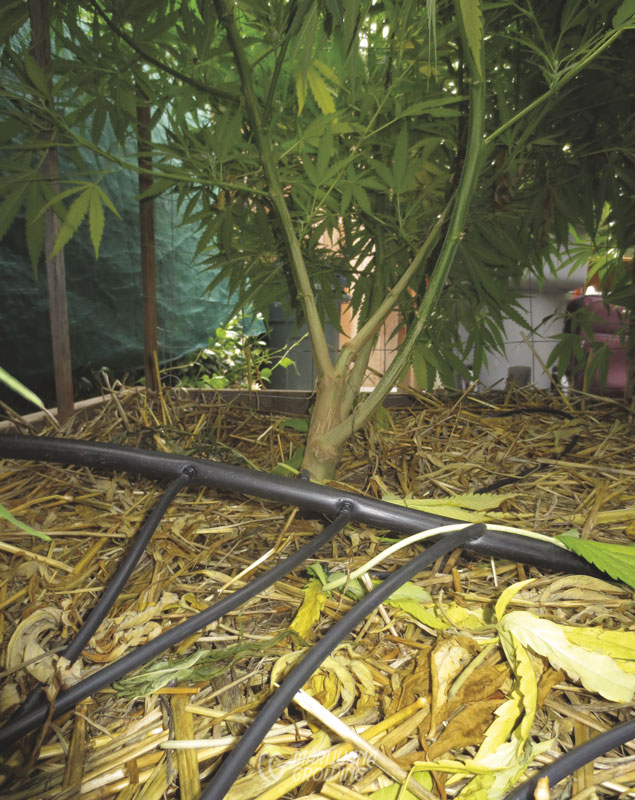
The plants used so much water that I installed a drip irrigation system to water plants daily. The drippers were unable to supply water evenly, so, as needed, I watered heavily using a wand with a breaker head that oxygenated the water. By August 24, plants were consuming even more water and were kept on the every-other-day schedule of about 40 to 60 gallons (151.4–227.1 L) in the entire 6 × 10-foot (182.9 × 304.8 cm) bed.
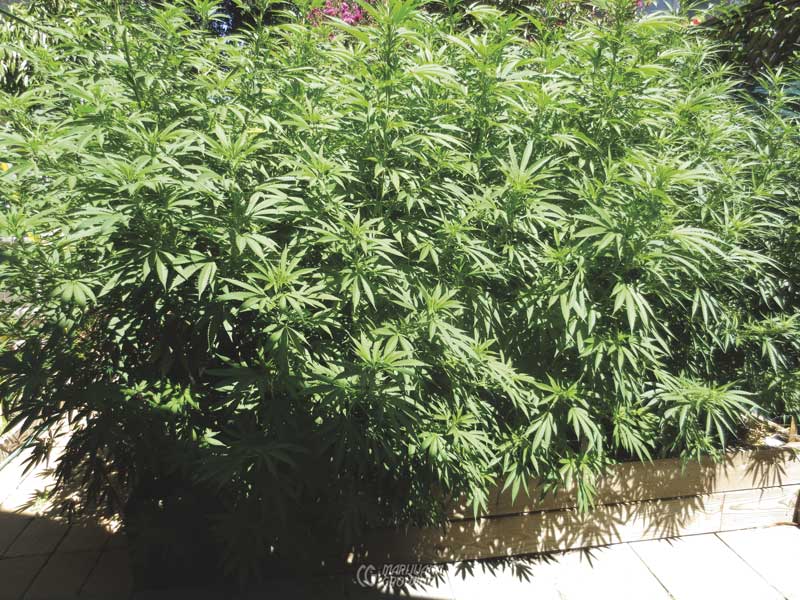
By August 21 the plants had overgrown the 6 × 10-foot (182.9 × 304.8 cm) raised bed. In this photo you can see that the top branches had started to shoot upward and small bracts and pistils had started to grow on the buds that were forming.
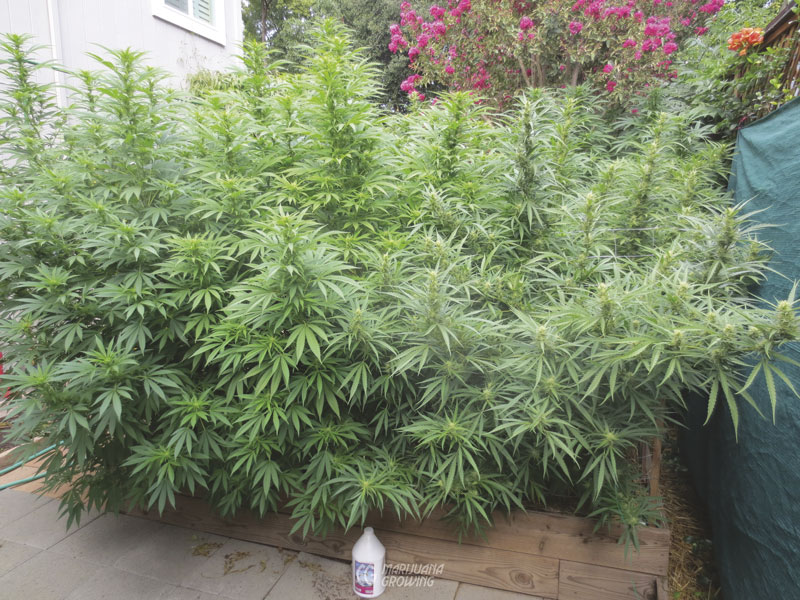
Flower-filled branches grew a foot (30.5 cm) or more between August 21 and September 5. Notice the ‘Apollo 13’ plant in the right foreground. Its buds were clearly much more developed than others. Note that the ‘Jack’s Cleaner’ branches on the left were not as far along in flowering. They received light from a nearby window during the nighttime.
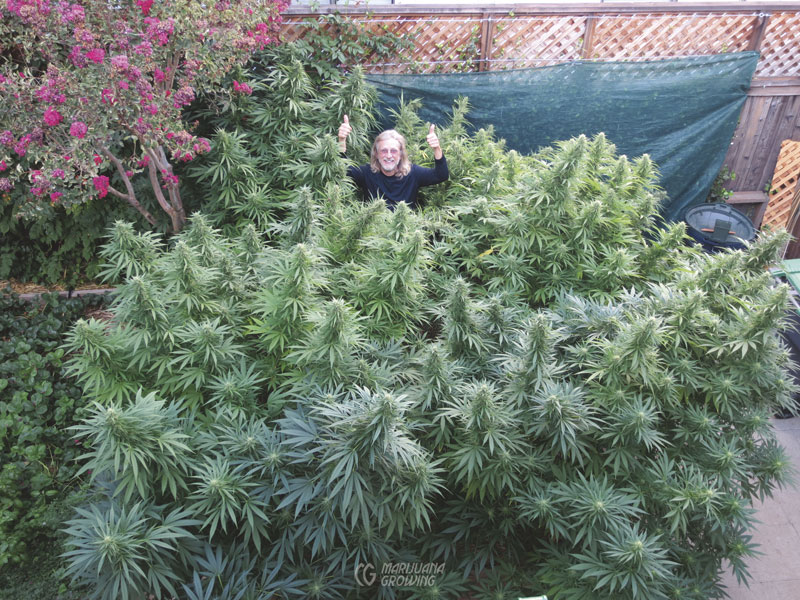
Here is a photo taken in late September from an upstairs window. The plants were from 5 to 7 feet (1.5–2.1 m) tall. Flower buds were getting so heavy that they weighed down the branches.
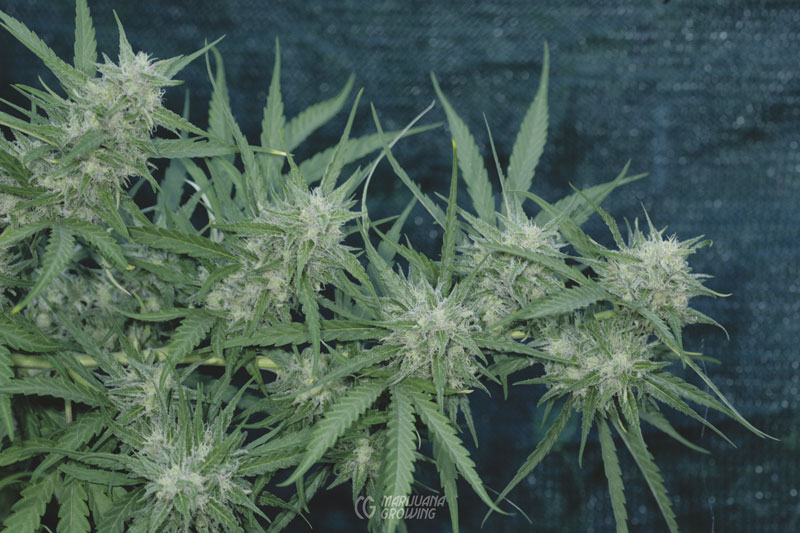
‘Apollo 13’ was the first to ripen, a full 2 weeks earlier than the rest of the garden. This image was taken September 27, a few weeks before harvest.
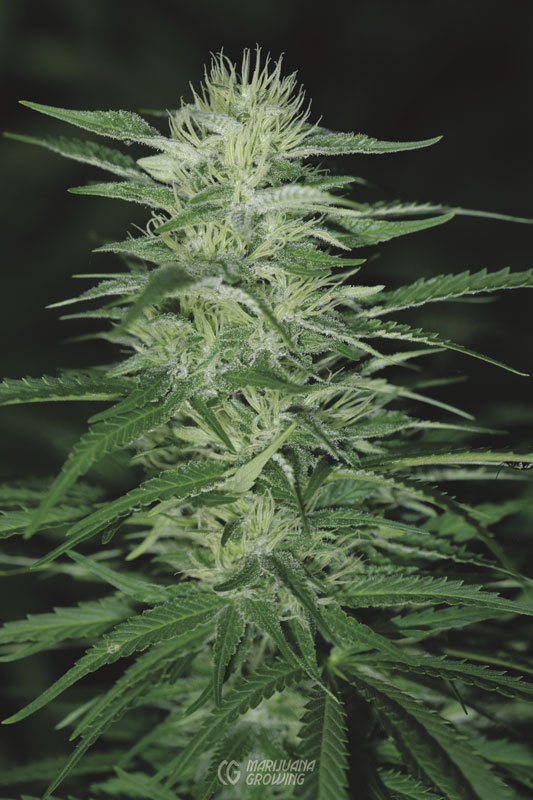
Here is a view of a ‘Jack’s Cleaner’ branch of flower buds that was photographed the same day as the previous image of ‘Apollo 13’. Notice that this bud was bigger and slower to mature.
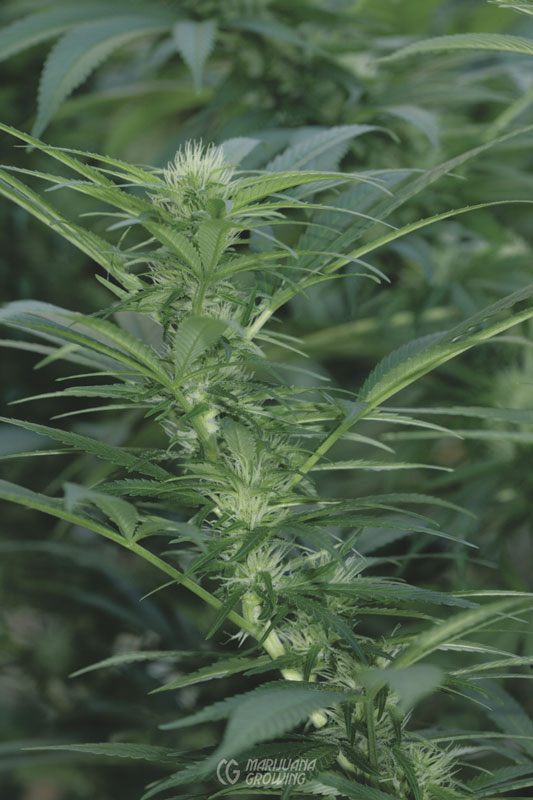
This photo is of a branch of flower buds from the same ‘Jack’s Cleaner’ plant as above. It was taken the same day, September 27, as the previous 2 images. It was underdeveloped and smaller overall because it received light from a nearby window during nighttime hours.

